Research Proposal: Teenagers' Social Media Bullying Experiences
VerifiedAdded on 2023/06/11
|12
|3183
|162
Report
AI Summary
This research proposal investigates the experiences of teenagers in the UK who have been subjected to social media bullying. The primary research question focuses on how these teenagers have handled the aftermath of such bullying, while a secondary question explores the physical, intellectual, emotional, and social impacts of social media bullying. The proposal includes a review of relevant literature, identifying key themes such as teenage bullying, mental health, social isolation, the role of social media, and the unique characteristics of teenagers. The project aims to understand how social media facilitates bullying and its effects on teenagers, suggesting ways for victims to build courage and overcome challenges. Ethical considerations are addressed, emphasizing data handling and plagiarism avoidance. The methodology section outlines a qualitative approach, utilizing phenomenology to interpret the experiences of teenagers who have shared their stories through blogs and videos.

1
Research Proposal
Name
Institution
Instructor
Date
Research Proposal
Name
Institution
Instructor
Date
Paraphrase This Document
Need a fresh take? Get an instant paraphrase of this document with our AI Paraphraser
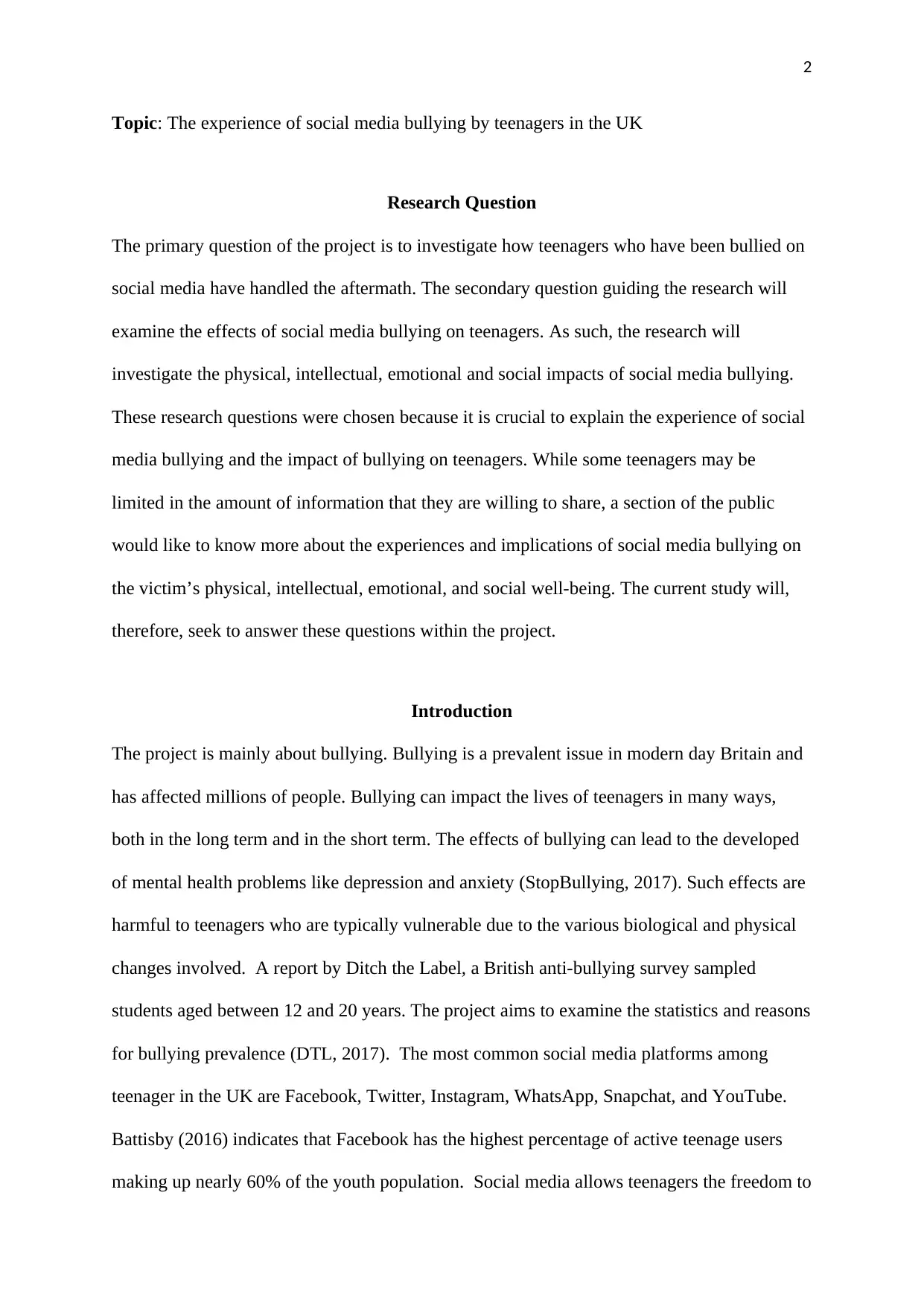
2
Topic: The experience of social media bullying by teenagers in the UK
Research Question
The primary question of the project is to investigate how teenagers who have been bullied on
social media have handled the aftermath. The secondary question guiding the research will
examine the effects of social media bullying on teenagers. As such, the research will
investigate the physical, intellectual, emotional and social impacts of social media bullying.
These research questions were chosen because it is crucial to explain the experience of social
media bullying and the impact of bullying on teenagers. While some teenagers may be
limited in the amount of information that they are willing to share, a section of the public
would like to know more about the experiences and implications of social media bullying on
the victim’s physical, intellectual, emotional, and social well-being. The current study will,
therefore, seek to answer these questions within the project.
Introduction
The project is mainly about bullying. Bullying is a prevalent issue in modern day Britain and
has affected millions of people. Bullying can impact the lives of teenagers in many ways,
both in the long term and in the short term. The effects of bullying can lead to the developed
of mental health problems like depression and anxiety (StopBullying, 2017). Such effects are
harmful to teenagers who are typically vulnerable due to the various biological and physical
changes involved. A report by Ditch the Label, a British anti-bullying survey sampled
students aged between 12 and 20 years. The project aims to examine the statistics and reasons
for bullying prevalence (DTL, 2017). The most common social media platforms among
teenager in the UK are Facebook, Twitter, Instagram, WhatsApp, Snapchat, and YouTube.
Battisby (2016) indicates that Facebook has the highest percentage of active teenage users
making up nearly 60% of the youth population. Social media allows teenagers the freedom to
Topic: The experience of social media bullying by teenagers in the UK
Research Question
The primary question of the project is to investigate how teenagers who have been bullied on
social media have handled the aftermath. The secondary question guiding the research will
examine the effects of social media bullying on teenagers. As such, the research will
investigate the physical, intellectual, emotional and social impacts of social media bullying.
These research questions were chosen because it is crucial to explain the experience of social
media bullying and the impact of bullying on teenagers. While some teenagers may be
limited in the amount of information that they are willing to share, a section of the public
would like to know more about the experiences and implications of social media bullying on
the victim’s physical, intellectual, emotional, and social well-being. The current study will,
therefore, seek to answer these questions within the project.
Introduction
The project is mainly about bullying. Bullying is a prevalent issue in modern day Britain and
has affected millions of people. Bullying can impact the lives of teenagers in many ways,
both in the long term and in the short term. The effects of bullying can lead to the developed
of mental health problems like depression and anxiety (StopBullying, 2017). Such effects are
harmful to teenagers who are typically vulnerable due to the various biological and physical
changes involved. A report by Ditch the Label, a British anti-bullying survey sampled
students aged between 12 and 20 years. The project aims to examine the statistics and reasons
for bullying prevalence (DTL, 2017). The most common social media platforms among
teenager in the UK are Facebook, Twitter, Instagram, WhatsApp, Snapchat, and YouTube.
Battisby (2016) indicates that Facebook has the highest percentage of active teenage users
making up nearly 60% of the youth population. Social media allows teenagers the freedom to
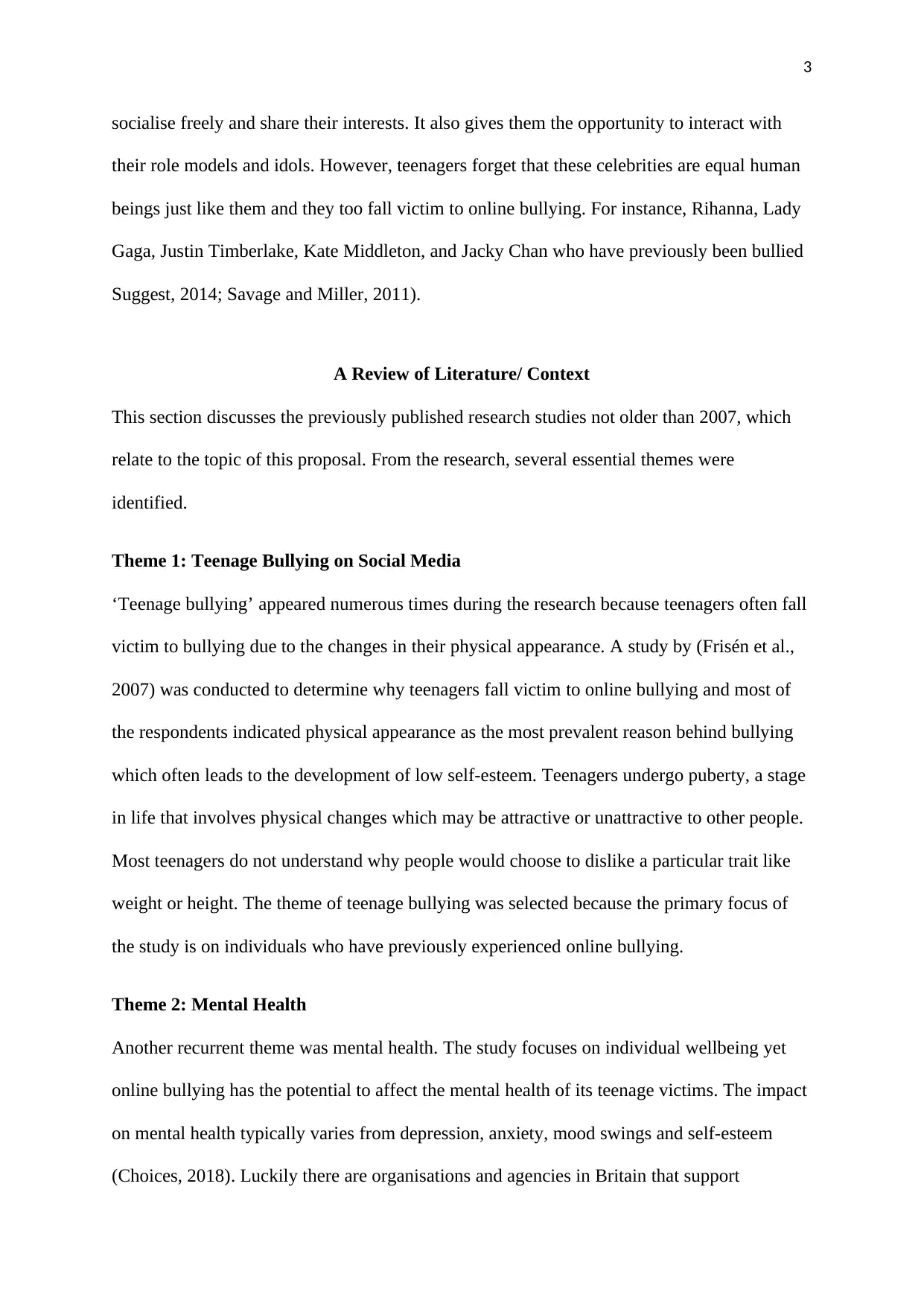
3
socialise freely and share their interests. It also gives them the opportunity to interact with
their role models and idols. However, teenagers forget that these celebrities are equal human
beings just like them and they too fall victim to online bullying. For instance, Rihanna, Lady
Gaga, Justin Timberlake, Kate Middleton, and Jacky Chan who have previously been bullied
Suggest, 2014; Savage and Miller, 2011).
A Review of Literature/ Context
This section discusses the previously published research studies not older than 2007, which
relate to the topic of this proposal. From the research, several essential themes were
identified.
Theme 1: Teenage Bullying on Social Media
‘Teenage bullying’ appeared numerous times during the research because teenagers often fall
victim to bullying due to the changes in their physical appearance. A study by (Frisén et al.,
2007) was conducted to determine why teenagers fall victim to online bullying and most of
the respondents indicated physical appearance as the most prevalent reason behind bullying
which often leads to the development of low self-esteem. Teenagers undergo puberty, a stage
in life that involves physical changes which may be attractive or unattractive to other people.
Most teenagers do not understand why people would choose to dislike a particular trait like
weight or height. The theme of teenage bullying was selected because the primary focus of
the study is on individuals who have previously experienced online bullying.
Theme 2: Mental Health
Another recurrent theme was mental health. The study focuses on individual wellbeing yet
online bullying has the potential to affect the mental health of its teenage victims. The impact
on mental health typically varies from depression, anxiety, mood swings and self-esteem
(Choices, 2018). Luckily there are organisations and agencies in Britain that support
socialise freely and share their interests. It also gives them the opportunity to interact with
their role models and idols. However, teenagers forget that these celebrities are equal human
beings just like them and they too fall victim to online bullying. For instance, Rihanna, Lady
Gaga, Justin Timberlake, Kate Middleton, and Jacky Chan who have previously been bullied
Suggest, 2014; Savage and Miller, 2011).
A Review of Literature/ Context
This section discusses the previously published research studies not older than 2007, which
relate to the topic of this proposal. From the research, several essential themes were
identified.
Theme 1: Teenage Bullying on Social Media
‘Teenage bullying’ appeared numerous times during the research because teenagers often fall
victim to bullying due to the changes in their physical appearance. A study by (Frisén et al.,
2007) was conducted to determine why teenagers fall victim to online bullying and most of
the respondents indicated physical appearance as the most prevalent reason behind bullying
which often leads to the development of low self-esteem. Teenagers undergo puberty, a stage
in life that involves physical changes which may be attractive or unattractive to other people.
Most teenagers do not understand why people would choose to dislike a particular trait like
weight or height. The theme of teenage bullying was selected because the primary focus of
the study is on individuals who have previously experienced online bullying.
Theme 2: Mental Health
Another recurrent theme was mental health. The study focuses on individual wellbeing yet
online bullying has the potential to affect the mental health of its teenage victims. The impact
on mental health typically varies from depression, anxiety, mood swings and self-esteem
(Choices, 2018). Luckily there are organisations and agencies in Britain that support
⊘ This is a preview!⊘
Do you want full access?
Subscribe today to unlock all pages.

Trusted by 1+ million students worldwide
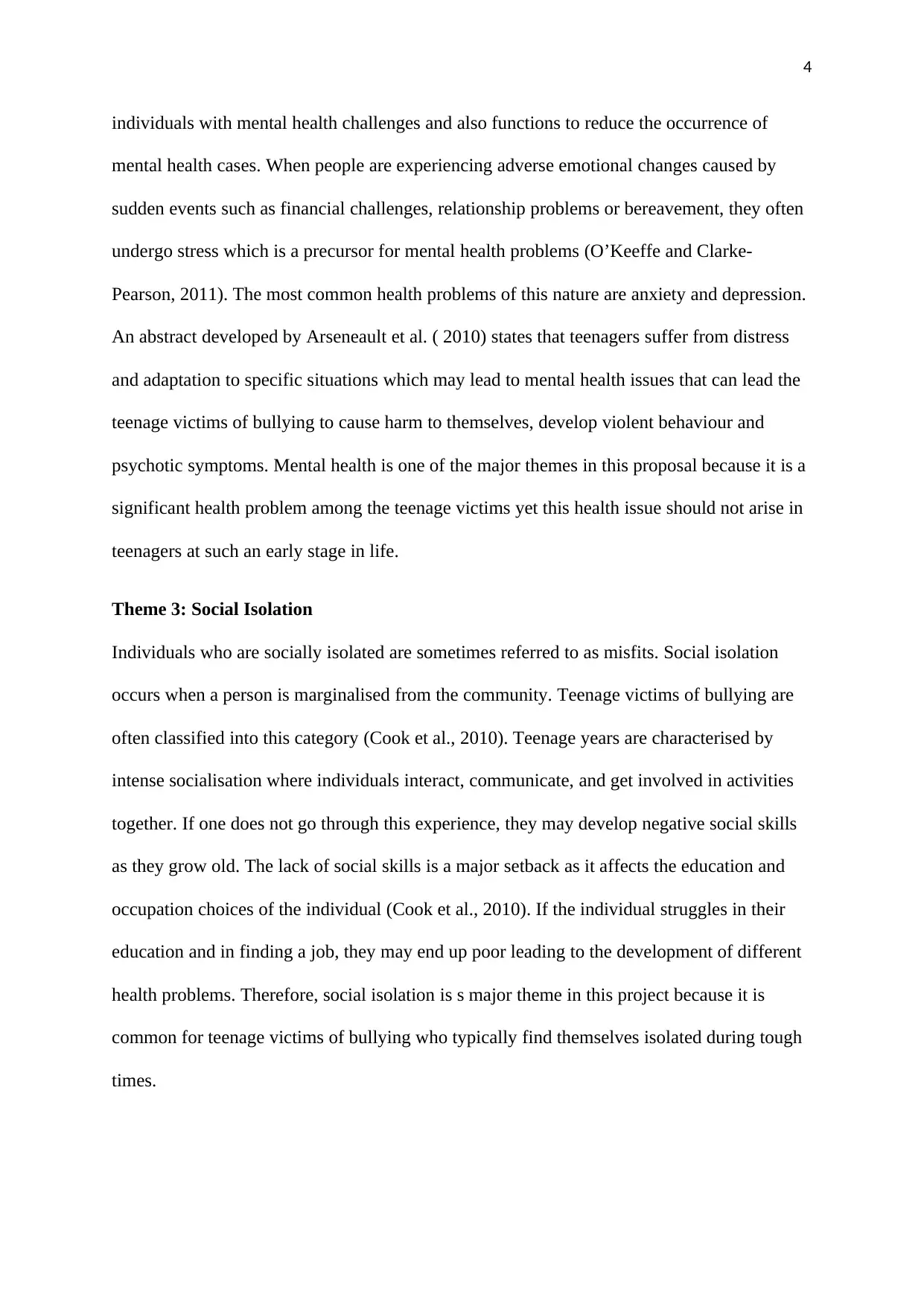
4
individuals with mental health challenges and also functions to reduce the occurrence of
mental health cases. When people are experiencing adverse emotional changes caused by
sudden events such as financial challenges, relationship problems or bereavement, they often
undergo stress which is a precursor for mental health problems (O’Keeffe and Clarke-
Pearson, 2011). The most common health problems of this nature are anxiety and depression.
An abstract developed by Arseneault et al. ( 2010) states that teenagers suffer from distress
and adaptation to specific situations which may lead to mental health issues that can lead the
teenage victims of bullying to cause harm to themselves, develop violent behaviour and
psychotic symptoms. Mental health is one of the major themes in this proposal because it is a
significant health problem among the teenage victims yet this health issue should not arise in
teenagers at such an early stage in life.
Theme 3: Social Isolation
Individuals who are socially isolated are sometimes referred to as misfits. Social isolation
occurs when a person is marginalised from the community. Teenage victims of bullying are
often classified into this category (Cook et al., 2010). Teenage years are characterised by
intense socialisation where individuals interact, communicate, and get involved in activities
together. If one does not go through this experience, they may develop negative social skills
as they grow old. The lack of social skills is a major setback as it affects the education and
occupation choices of the individual (Cook et al., 2010). If the individual struggles in their
education and in finding a job, they may end up poor leading to the development of different
health problems. Therefore, social isolation is s major theme in this project because it is
common for teenage victims of bullying who typically find themselves isolated during tough
times.
individuals with mental health challenges and also functions to reduce the occurrence of
mental health cases. When people are experiencing adverse emotional changes caused by
sudden events such as financial challenges, relationship problems or bereavement, they often
undergo stress which is a precursor for mental health problems (O’Keeffe and Clarke-
Pearson, 2011). The most common health problems of this nature are anxiety and depression.
An abstract developed by Arseneault et al. ( 2010) states that teenagers suffer from distress
and adaptation to specific situations which may lead to mental health issues that can lead the
teenage victims of bullying to cause harm to themselves, develop violent behaviour and
psychotic symptoms. Mental health is one of the major themes in this proposal because it is a
significant health problem among the teenage victims yet this health issue should not arise in
teenagers at such an early stage in life.
Theme 3: Social Isolation
Individuals who are socially isolated are sometimes referred to as misfits. Social isolation
occurs when a person is marginalised from the community. Teenage victims of bullying are
often classified into this category (Cook et al., 2010). Teenage years are characterised by
intense socialisation where individuals interact, communicate, and get involved in activities
together. If one does not go through this experience, they may develop negative social skills
as they grow old. The lack of social skills is a major setback as it affects the education and
occupation choices of the individual (Cook et al., 2010). If the individual struggles in their
education and in finding a job, they may end up poor leading to the development of different
health problems. Therefore, social isolation is s major theme in this project because it is
common for teenage victims of bullying who typically find themselves isolated during tough
times.
Paraphrase This Document
Need a fresh take? Get an instant paraphrase of this document with our AI Paraphraser
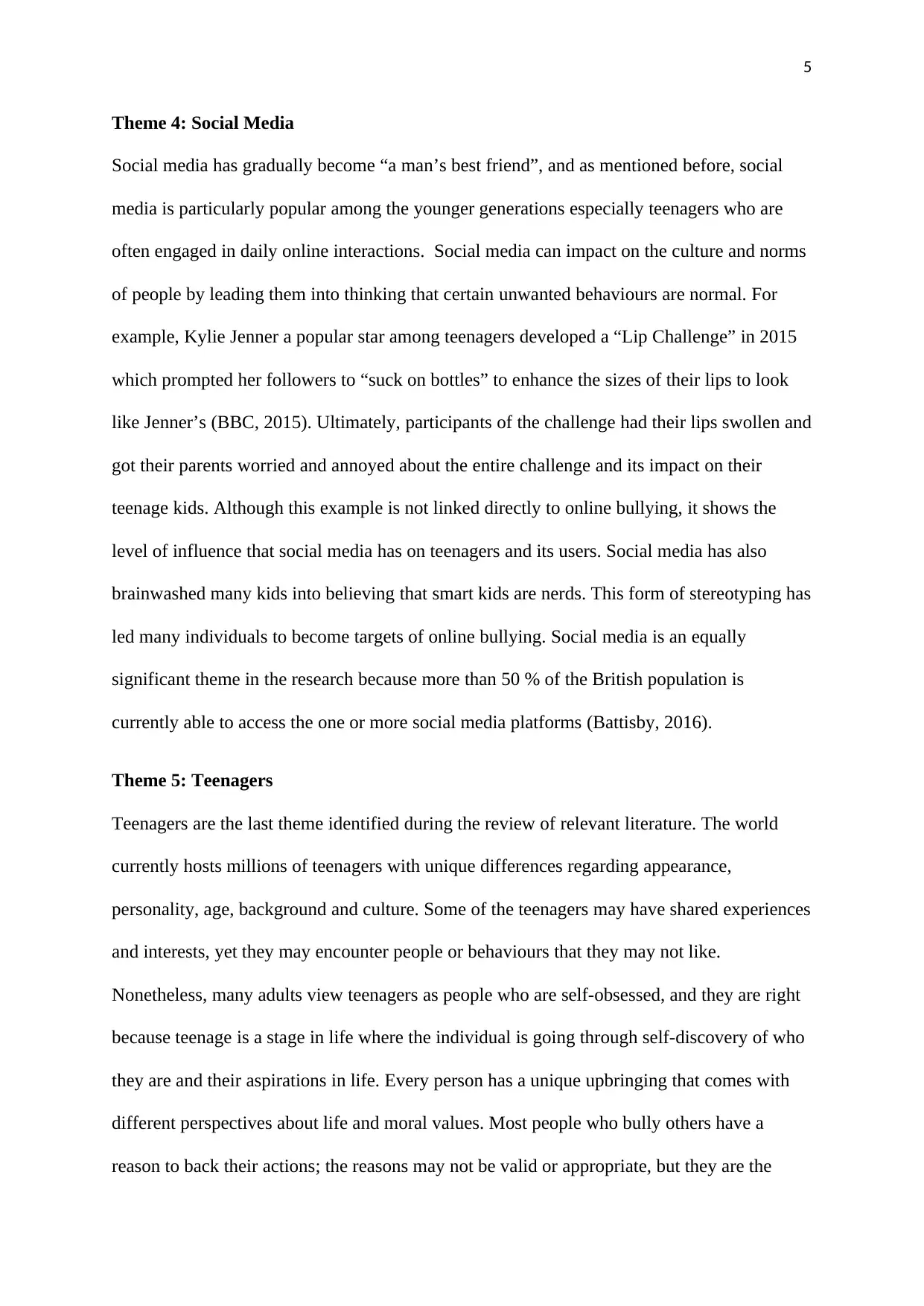
5
Theme 4: Social Media
Social media has gradually become “a man’s best friend”, and as mentioned before, social
media is particularly popular among the younger generations especially teenagers who are
often engaged in daily online interactions. Social media can impact on the culture and norms
of people by leading them into thinking that certain unwanted behaviours are normal. For
example, Kylie Jenner a popular star among teenagers developed a “Lip Challenge” in 2015
which prompted her followers to “suck on bottles” to enhance the sizes of their lips to look
like Jenner’s (BBC, 2015). Ultimately, participants of the challenge had their lips swollen and
got their parents worried and annoyed about the entire challenge and its impact on their
teenage kids. Although this example is not linked directly to online bullying, it shows the
level of influence that social media has on teenagers and its users. Social media has also
brainwashed many kids into believing that smart kids are nerds. This form of stereotyping has
led many individuals to become targets of online bullying. Social media is an equally
significant theme in the research because more than 50 % of the British population is
currently able to access the one or more social media platforms (Battisby, 2016).
Theme 5: Teenagers
Teenagers are the last theme identified during the review of relevant literature. The world
currently hosts millions of teenagers with unique differences regarding appearance,
personality, age, background and culture. Some of the teenagers may have shared experiences
and interests, yet they may encounter people or behaviours that they may not like.
Nonetheless, many adults view teenagers as people who are self-obsessed, and they are right
because teenage is a stage in life where the individual is going through self-discovery of who
they are and their aspirations in life. Every person has a unique upbringing that comes with
different perspectives about life and moral values. Most people who bully others have a
reason to back their actions; the reasons may not be valid or appropriate, but they are the
Theme 4: Social Media
Social media has gradually become “a man’s best friend”, and as mentioned before, social
media is particularly popular among the younger generations especially teenagers who are
often engaged in daily online interactions. Social media can impact on the culture and norms
of people by leading them into thinking that certain unwanted behaviours are normal. For
example, Kylie Jenner a popular star among teenagers developed a “Lip Challenge” in 2015
which prompted her followers to “suck on bottles” to enhance the sizes of their lips to look
like Jenner’s (BBC, 2015). Ultimately, participants of the challenge had their lips swollen and
got their parents worried and annoyed about the entire challenge and its impact on their
teenage kids. Although this example is not linked directly to online bullying, it shows the
level of influence that social media has on teenagers and its users. Social media has also
brainwashed many kids into believing that smart kids are nerds. This form of stereotyping has
led many individuals to become targets of online bullying. Social media is an equally
significant theme in the research because more than 50 % of the British population is
currently able to access the one or more social media platforms (Battisby, 2016).
Theme 5: Teenagers
Teenagers are the last theme identified during the review of relevant literature. The world
currently hosts millions of teenagers with unique differences regarding appearance,
personality, age, background and culture. Some of the teenagers may have shared experiences
and interests, yet they may encounter people or behaviours that they may not like.
Nonetheless, many adults view teenagers as people who are self-obsessed, and they are right
because teenage is a stage in life where the individual is going through self-discovery of who
they are and their aspirations in life. Every person has a unique upbringing that comes with
different perspectives about life and moral values. Most people who bully others have a
reason to back their actions; the reasons may not be valid or appropriate, but they are the
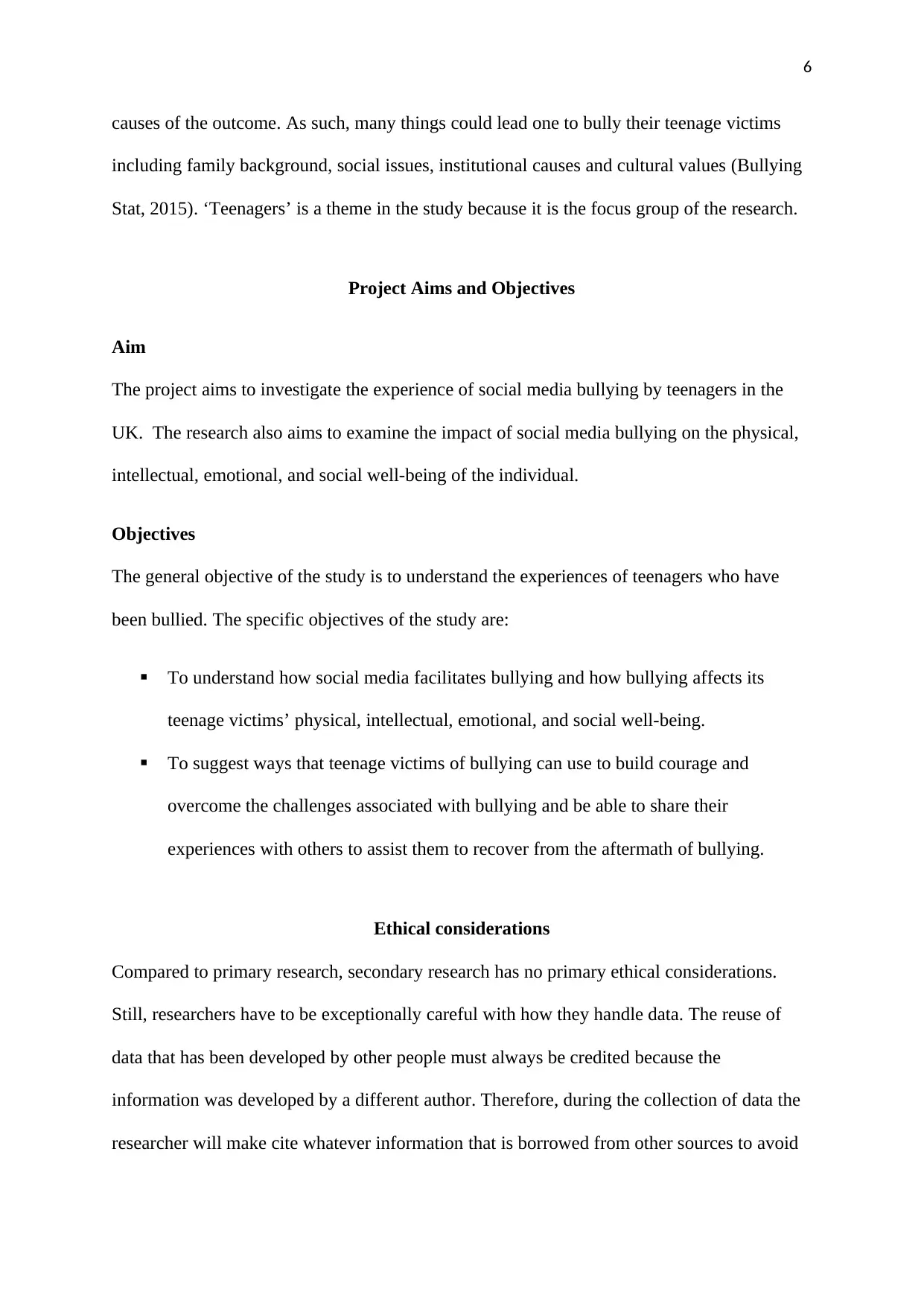
6
causes of the outcome. As such, many things could lead one to bully their teenage victims
including family background, social issues, institutional causes and cultural values (Bullying
Stat, 2015). ‘Teenagers’ is a theme in the study because it is the focus group of the research.
Project Aims and Objectives
Aim
The project aims to investigate the experience of social media bullying by teenagers in the
UK. The research also aims to examine the impact of social media bullying on the physical,
intellectual, emotional, and social well-being of the individual.
Objectives
The general objective of the study is to understand the experiences of teenagers who have
been bullied. The specific objectives of the study are:
To understand how social media facilitates bullying and how bullying affects its
teenage victims’ physical, intellectual, emotional, and social well-being.
To suggest ways that teenage victims of bullying can use to build courage and
overcome the challenges associated with bullying and be able to share their
experiences with others to assist them to recover from the aftermath of bullying.
Ethical considerations
Compared to primary research, secondary research has no primary ethical considerations.
Still, researchers have to be exceptionally careful with how they handle data. The reuse of
data that has been developed by other people must always be credited because the
information was developed by a different author. Therefore, during the collection of data the
researcher will make cite whatever information that is borrowed from other sources to avoid
causes of the outcome. As such, many things could lead one to bully their teenage victims
including family background, social issues, institutional causes and cultural values (Bullying
Stat, 2015). ‘Teenagers’ is a theme in the study because it is the focus group of the research.
Project Aims and Objectives
Aim
The project aims to investigate the experience of social media bullying by teenagers in the
UK. The research also aims to examine the impact of social media bullying on the physical,
intellectual, emotional, and social well-being of the individual.
Objectives
The general objective of the study is to understand the experiences of teenagers who have
been bullied. The specific objectives of the study are:
To understand how social media facilitates bullying and how bullying affects its
teenage victims’ physical, intellectual, emotional, and social well-being.
To suggest ways that teenage victims of bullying can use to build courage and
overcome the challenges associated with bullying and be able to share their
experiences with others to assist them to recover from the aftermath of bullying.
Ethical considerations
Compared to primary research, secondary research has no primary ethical considerations.
Still, researchers have to be exceptionally careful with how they handle data. The reuse of
data that has been developed by other people must always be credited because the
information was developed by a different author. Therefore, during the collection of data the
researcher will make cite whatever information that is borrowed from other sources to avoid
⊘ This is a preview!⊘
Do you want full access?
Subscribe today to unlock all pages.

Trusted by 1+ million students worldwide
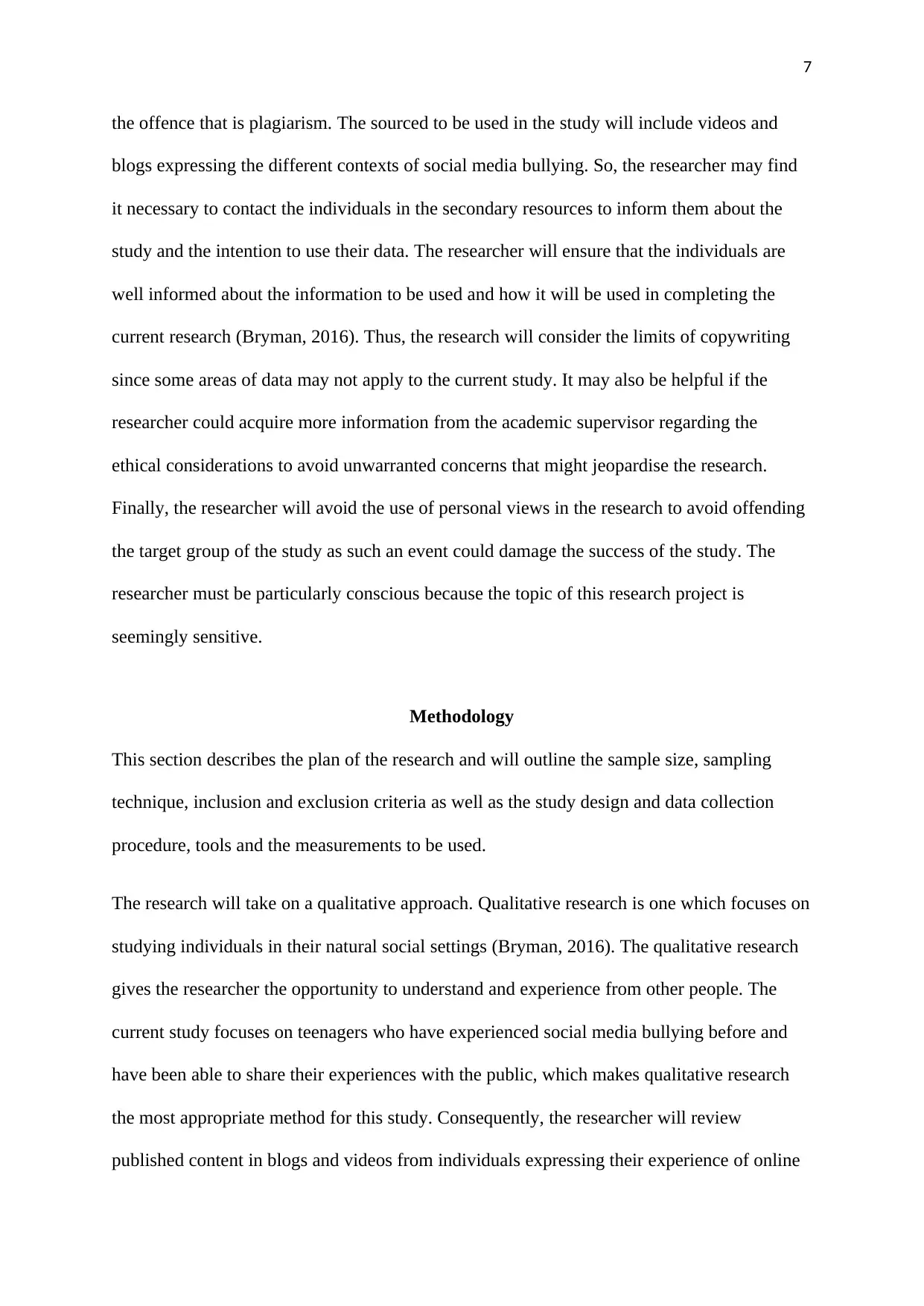
7
the offence that is plagiarism. The sourced to be used in the study will include videos and
blogs expressing the different contexts of social media bullying. So, the researcher may find
it necessary to contact the individuals in the secondary resources to inform them about the
study and the intention to use their data. The researcher will ensure that the individuals are
well informed about the information to be used and how it will be used in completing the
current research (Bryman, 2016). Thus, the research will consider the limits of copywriting
since some areas of data may not apply to the current study. It may also be helpful if the
researcher could acquire more information from the academic supervisor regarding the
ethical considerations to avoid unwarranted concerns that might jeopardise the research.
Finally, the researcher will avoid the use of personal views in the research to avoid offending
the target group of the study as such an event could damage the success of the study. The
researcher must be particularly conscious because the topic of this research project is
seemingly sensitive.
Methodology
This section describes the plan of the research and will outline the sample size, sampling
technique, inclusion and exclusion criteria as well as the study design and data collection
procedure, tools and the measurements to be used.
The research will take on a qualitative approach. Qualitative research is one which focuses on
studying individuals in their natural social settings (Bryman, 2016). The qualitative research
gives the researcher the opportunity to understand and experience from other people. The
current study focuses on teenagers who have experienced social media bullying before and
have been able to share their experiences with the public, which makes qualitative research
the most appropriate method for this study. Consequently, the researcher will review
published content in blogs and videos from individuals expressing their experience of online
the offence that is plagiarism. The sourced to be used in the study will include videos and
blogs expressing the different contexts of social media bullying. So, the researcher may find
it necessary to contact the individuals in the secondary resources to inform them about the
study and the intention to use their data. The researcher will ensure that the individuals are
well informed about the information to be used and how it will be used in completing the
current research (Bryman, 2016). Thus, the research will consider the limits of copywriting
since some areas of data may not apply to the current study. It may also be helpful if the
researcher could acquire more information from the academic supervisor regarding the
ethical considerations to avoid unwarranted concerns that might jeopardise the research.
Finally, the researcher will avoid the use of personal views in the research to avoid offending
the target group of the study as such an event could damage the success of the study. The
researcher must be particularly conscious because the topic of this research project is
seemingly sensitive.
Methodology
This section describes the plan of the research and will outline the sample size, sampling
technique, inclusion and exclusion criteria as well as the study design and data collection
procedure, tools and the measurements to be used.
The research will take on a qualitative approach. Qualitative research is one which focuses on
studying individuals in their natural social settings (Bryman, 2016). The qualitative research
gives the researcher the opportunity to understand and experience from other people. The
current study focuses on teenagers who have experienced social media bullying before and
have been able to share their experiences with the public, which makes qualitative research
the most appropriate method for this study. Consequently, the researcher will review
published content in blogs and videos from individuals expressing their experience of online
Paraphrase This Document
Need a fresh take? Get an instant paraphrase of this document with our AI Paraphraser
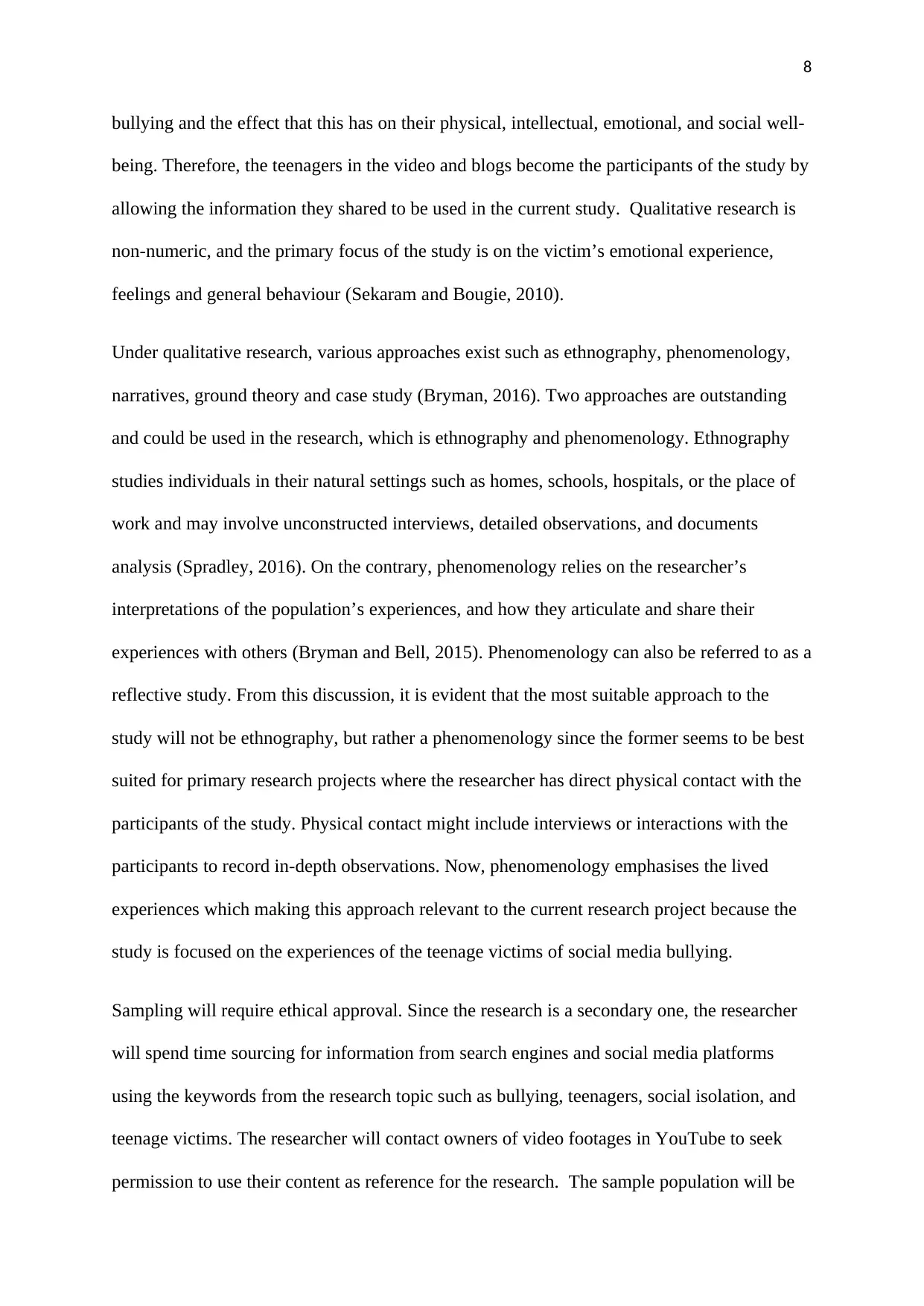
8
bullying and the effect that this has on their physical, intellectual, emotional, and social well-
being. Therefore, the teenagers in the video and blogs become the participants of the study by
allowing the information they shared to be used in the current study. Qualitative research is
non-numeric, and the primary focus of the study is on the victim’s emotional experience,
feelings and general behaviour (Sekaram and Bougie, 2010).
Under qualitative research, various approaches exist such as ethnography, phenomenology,
narratives, ground theory and case study (Bryman, 2016). Two approaches are outstanding
and could be used in the research, which is ethnography and phenomenology. Ethnography
studies individuals in their natural settings such as homes, schools, hospitals, or the place of
work and may involve unconstructed interviews, detailed observations, and documents
analysis (Spradley, 2016). On the contrary, phenomenology relies on the researcher’s
interpretations of the population’s experiences, and how they articulate and share their
experiences with others (Bryman and Bell, 2015). Phenomenology can also be referred to as a
reflective study. From this discussion, it is evident that the most suitable approach to the
study will not be ethnography, but rather a phenomenology since the former seems to be best
suited for primary research projects where the researcher has direct physical contact with the
participants of the study. Physical contact might include interviews or interactions with the
participants to record in-depth observations. Now, phenomenology emphasises the lived
experiences which making this approach relevant to the current research project because the
study is focused on the experiences of the teenage victims of social media bullying.
Sampling will require ethical approval. Since the research is a secondary one, the researcher
will spend time sourcing for information from search engines and social media platforms
using the keywords from the research topic such as bullying, teenagers, social isolation, and
teenage victims. The researcher will contact owners of video footages in YouTube to seek
permission to use their content as reference for the research. The sample population will be
bullying and the effect that this has on their physical, intellectual, emotional, and social well-
being. Therefore, the teenagers in the video and blogs become the participants of the study by
allowing the information they shared to be used in the current study. Qualitative research is
non-numeric, and the primary focus of the study is on the victim’s emotional experience,
feelings and general behaviour (Sekaram and Bougie, 2010).
Under qualitative research, various approaches exist such as ethnography, phenomenology,
narratives, ground theory and case study (Bryman, 2016). Two approaches are outstanding
and could be used in the research, which is ethnography and phenomenology. Ethnography
studies individuals in their natural settings such as homes, schools, hospitals, or the place of
work and may involve unconstructed interviews, detailed observations, and documents
analysis (Spradley, 2016). On the contrary, phenomenology relies on the researcher’s
interpretations of the population’s experiences, and how they articulate and share their
experiences with others (Bryman and Bell, 2015). Phenomenology can also be referred to as a
reflective study. From this discussion, it is evident that the most suitable approach to the
study will not be ethnography, but rather a phenomenology since the former seems to be best
suited for primary research projects where the researcher has direct physical contact with the
participants of the study. Physical contact might include interviews or interactions with the
participants to record in-depth observations. Now, phenomenology emphasises the lived
experiences which making this approach relevant to the current research project because the
study is focused on the experiences of the teenage victims of social media bullying.
Sampling will require ethical approval. Since the research is a secondary one, the researcher
will spend time sourcing for information from search engines and social media platforms
using the keywords from the research topic such as bullying, teenagers, social isolation, and
teenage victims. The researcher will contact owners of video footages in YouTube to seek
permission to use their content as reference for the research. The sample population will be
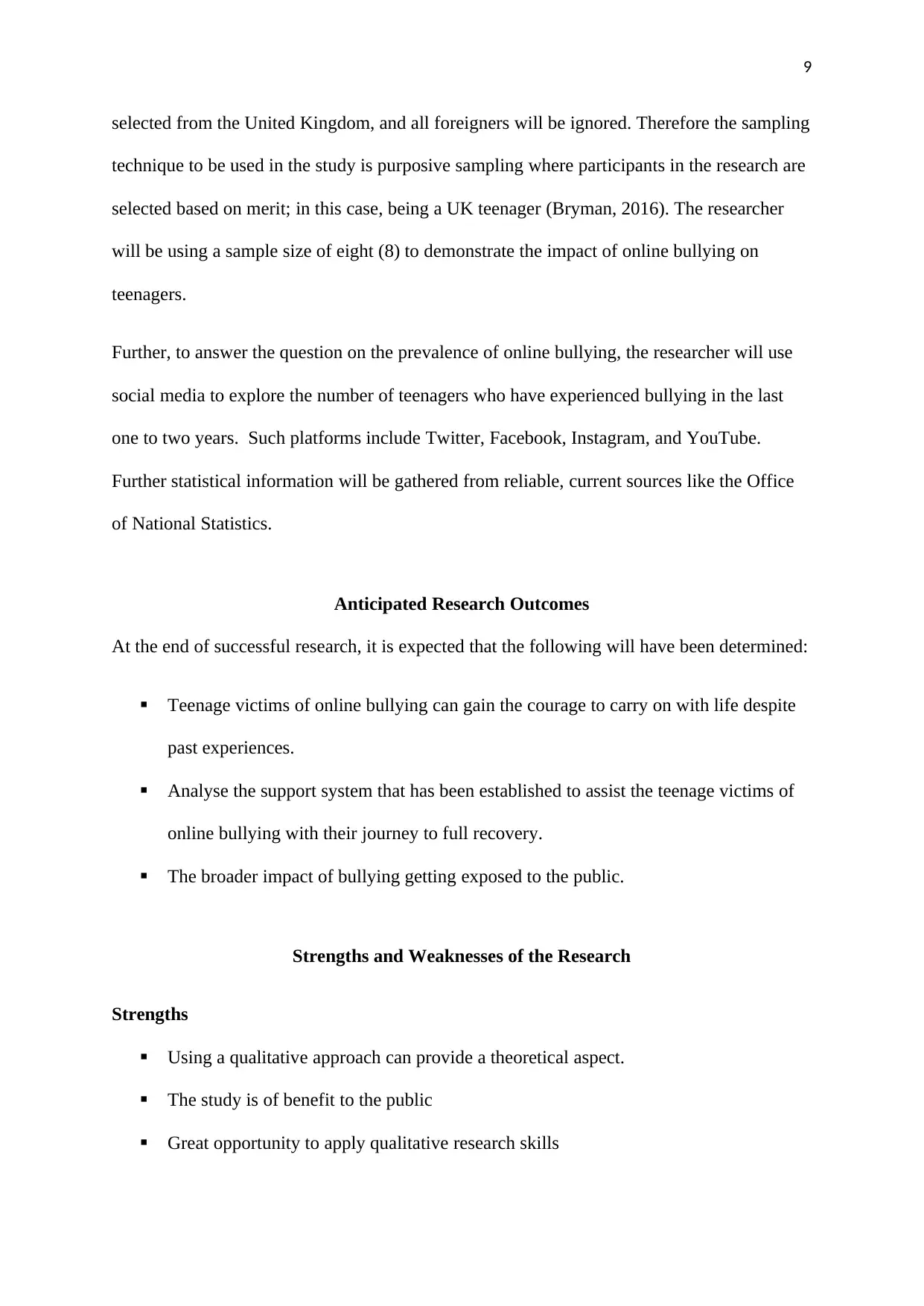
9
selected from the United Kingdom, and all foreigners will be ignored. Therefore the sampling
technique to be used in the study is purposive sampling where participants in the research are
selected based on merit; in this case, being a UK teenager (Bryman, 2016). The researcher
will be using a sample size of eight (8) to demonstrate the impact of online bullying on
teenagers.
Further, to answer the question on the prevalence of online bullying, the researcher will use
social media to explore the number of teenagers who have experienced bullying in the last
one to two years. Such platforms include Twitter, Facebook, Instagram, and YouTube.
Further statistical information will be gathered from reliable, current sources like the Office
of National Statistics.
Anticipated Research Outcomes
At the end of successful research, it is expected that the following will have been determined:
Teenage victims of online bullying can gain the courage to carry on with life despite
past experiences.
Analyse the support system that has been established to assist the teenage victims of
online bullying with their journey to full recovery.
The broader impact of bullying getting exposed to the public.
Strengths and Weaknesses of the Research
Strengths
Using a qualitative approach can provide a theoretical aspect.
The study is of benefit to the public
Great opportunity to apply qualitative research skills
selected from the United Kingdom, and all foreigners will be ignored. Therefore the sampling
technique to be used in the study is purposive sampling where participants in the research are
selected based on merit; in this case, being a UK teenager (Bryman, 2016). The researcher
will be using a sample size of eight (8) to demonstrate the impact of online bullying on
teenagers.
Further, to answer the question on the prevalence of online bullying, the researcher will use
social media to explore the number of teenagers who have experienced bullying in the last
one to two years. Such platforms include Twitter, Facebook, Instagram, and YouTube.
Further statistical information will be gathered from reliable, current sources like the Office
of National Statistics.
Anticipated Research Outcomes
At the end of successful research, it is expected that the following will have been determined:
Teenage victims of online bullying can gain the courage to carry on with life despite
past experiences.
Analyse the support system that has been established to assist the teenage victims of
online bullying with their journey to full recovery.
The broader impact of bullying getting exposed to the public.
Strengths and Weaknesses of the Research
Strengths
Using a qualitative approach can provide a theoretical aspect.
The study is of benefit to the public
Great opportunity to apply qualitative research skills
⊘ This is a preview!⊘
Do you want full access?
Subscribe today to unlock all pages.

Trusted by 1+ million students worldwide

10
Social media analysis and qualitative research are a great match
Weaknesses
Relevant data is not readily accessible
YouTube account holders may fail to cooperate
First time applying qualitative approach skills in research
The possible misconception of the data collected
Work Plan
The work plan is outlined in the following Gantt chart showing every step of the project and
the milestone to be achieved along the way for eight months
Action Oct Nov Dec Jan Feb Mar Apr May
Background information
Research Proposal
Literature Review
Research methodology
Data collection
Data analysis
Review project milestones
Conclusion
Further drafts
Further meetings
Final draft
Social media analysis and qualitative research are a great match
Weaknesses
Relevant data is not readily accessible
YouTube account holders may fail to cooperate
First time applying qualitative approach skills in research
The possible misconception of the data collected
Work Plan
The work plan is outlined in the following Gantt chart showing every step of the project and
the milestone to be achieved along the way for eight months
Action Oct Nov Dec Jan Feb Mar Apr May
Background information
Research Proposal
Literature Review
Research methodology
Data collection
Data analysis
Review project milestones
Conclusion
Further drafts
Further meetings
Final draft
Paraphrase This Document
Need a fresh take? Get an instant paraphrase of this document with our AI Paraphraser
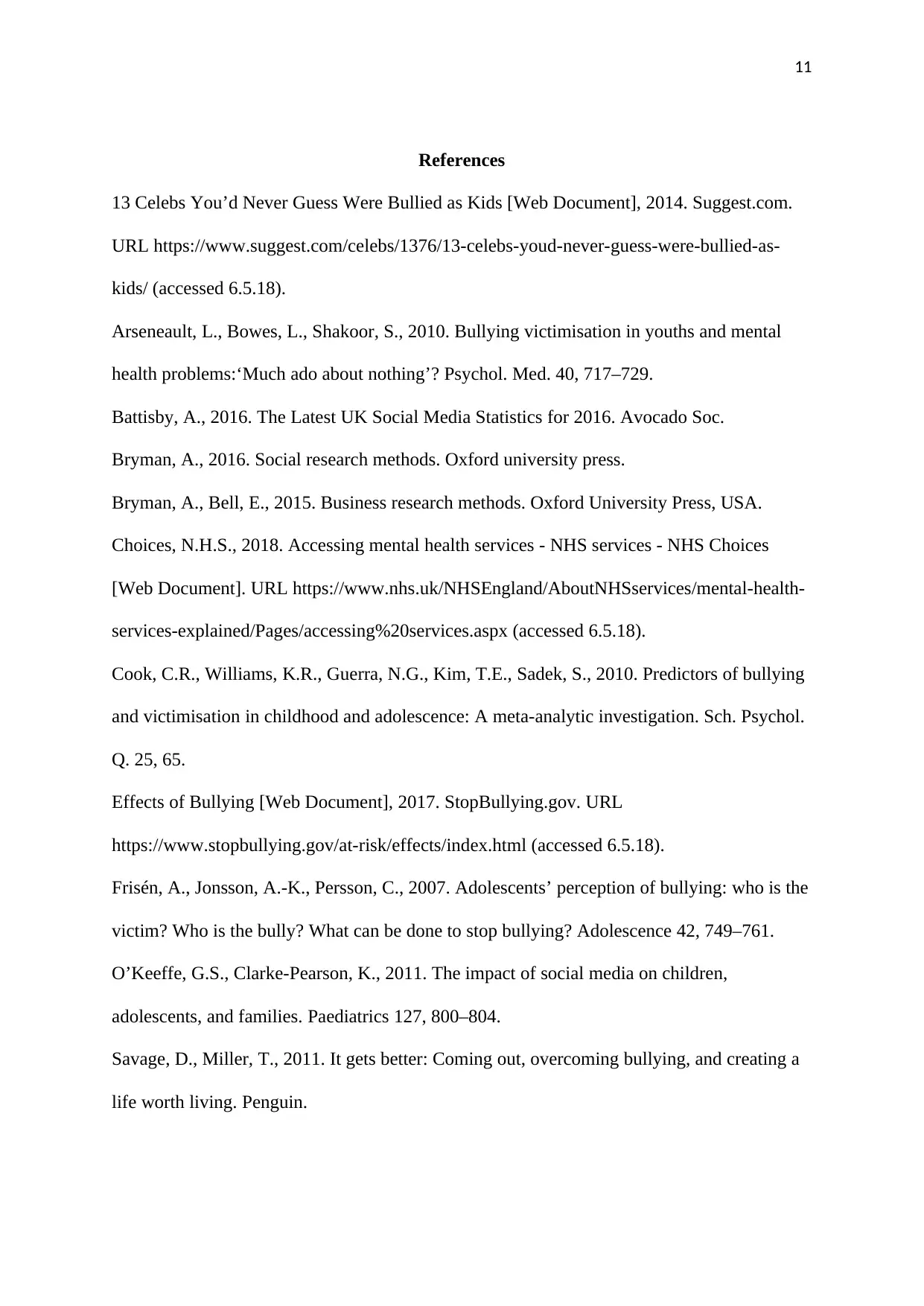
11
References
13 Celebs You’d Never Guess Were Bullied as Kids [Web Document], 2014. Suggest.com.
URL https://www.suggest.com/celebs/1376/13-celebs-youd-never-guess-were-bullied-as-
kids/ (accessed 6.5.18).
Arseneault, L., Bowes, L., Shakoor, S., 2010. Bullying victimisation in youths and mental
health problems:‘Much ado about nothing’? Psychol. Med. 40, 717–729.
Battisby, A., 2016. The Latest UK Social Media Statistics for 2016. Avocado Soc.
Bryman, A., 2016. Social research methods. Oxford university press.
Bryman, A., Bell, E., 2015. Business research methods. Oxford University Press, USA.
Choices, N.H.S., 2018. Accessing mental health services - NHS services - NHS Choices
[Web Document]. URL https://www.nhs.uk/NHSEngland/AboutNHSservices/mental-health-
services-explained/Pages/accessing%20services.aspx (accessed 6.5.18).
Cook, C.R., Williams, K.R., Guerra, N.G., Kim, T.E., Sadek, S., 2010. Predictors of bullying
and victimisation in childhood and adolescence: A meta-analytic investigation. Sch. Psychol.
Q. 25, 65.
Effects of Bullying [Web Document], 2017. StopBullying.gov. URL
https://www.stopbullying.gov/at-risk/effects/index.html (accessed 6.5.18).
Frisén, A., Jonsson, A.-K., Persson, C., 2007. Adolescents’ perception of bullying: who is the
victim? Who is the bully? What can be done to stop bullying? Adolescence 42, 749–761.
O’Keeffe, G.S., Clarke-Pearson, K., 2011. The impact of social media on children,
adolescents, and families. Paediatrics 127, 800–804.
Savage, D., Miller, T., 2011. It gets better: Coming out, overcoming bullying, and creating a
life worth living. Penguin.
References
13 Celebs You’d Never Guess Were Bullied as Kids [Web Document], 2014. Suggest.com.
URL https://www.suggest.com/celebs/1376/13-celebs-youd-never-guess-were-bullied-as-
kids/ (accessed 6.5.18).
Arseneault, L., Bowes, L., Shakoor, S., 2010. Bullying victimisation in youths and mental
health problems:‘Much ado about nothing’? Psychol. Med. 40, 717–729.
Battisby, A., 2016. The Latest UK Social Media Statistics for 2016. Avocado Soc.
Bryman, A., 2016. Social research methods. Oxford university press.
Bryman, A., Bell, E., 2015. Business research methods. Oxford University Press, USA.
Choices, N.H.S., 2018. Accessing mental health services - NHS services - NHS Choices
[Web Document]. URL https://www.nhs.uk/NHSEngland/AboutNHSservices/mental-health-
services-explained/Pages/accessing%20services.aspx (accessed 6.5.18).
Cook, C.R., Williams, K.R., Guerra, N.G., Kim, T.E., Sadek, S., 2010. Predictors of bullying
and victimisation in childhood and adolescence: A meta-analytic investigation. Sch. Psychol.
Q. 25, 65.
Effects of Bullying [Web Document], 2017. StopBullying.gov. URL
https://www.stopbullying.gov/at-risk/effects/index.html (accessed 6.5.18).
Frisén, A., Jonsson, A.-K., Persson, C., 2007. Adolescents’ perception of bullying: who is the
victim? Who is the bully? What can be done to stop bullying? Adolescence 42, 749–761.
O’Keeffe, G.S., Clarke-Pearson, K., 2011. The impact of social media on children,
adolescents, and families. Paediatrics 127, 800–804.
Savage, D., Miller, T., 2011. It gets better: Coming out, overcoming bullying, and creating a
life worth living. Penguin.

12
Sekaram, U., Bougie, R., 2010. Research Methods for Business: A Skill Building Approach.
John Wiley & Sons Ltd, United Kingdom.
Spradley, J.P., 2016. The ethnographic interview. Waveland Press.
The Annual Bullying Survey 2017 - Recommendations [Web Document], 2017. Ditch Label.
URL https://www.ditchthelabel.org/abs17/ (accessed 6.5.18).
The Kylie Jenner big lip challenge has weird results, 2015. BBC Newsbeat.
Why do People Bully? 2015. Bullying Stat.
Sekaram, U., Bougie, R., 2010. Research Methods for Business: A Skill Building Approach.
John Wiley & Sons Ltd, United Kingdom.
Spradley, J.P., 2016. The ethnographic interview. Waveland Press.
The Annual Bullying Survey 2017 - Recommendations [Web Document], 2017. Ditch Label.
URL https://www.ditchthelabel.org/abs17/ (accessed 6.5.18).
The Kylie Jenner big lip challenge has weird results, 2015. BBC Newsbeat.
Why do People Bully? 2015. Bullying Stat.
⊘ This is a preview!⊘
Do you want full access?
Subscribe today to unlock all pages.

Trusted by 1+ million students worldwide
1 out of 12
Your All-in-One AI-Powered Toolkit for Academic Success.
+13062052269
info@desklib.com
Available 24*7 on WhatsApp / Email
![[object Object]](/_next/static/media/star-bottom.7253800d.svg)
Unlock your academic potential
Copyright © 2020–2025 A2Z Services. All Rights Reserved. Developed and managed by ZUCOL.